Crashworthiness Optimization Design of Aluminum Alloy Thin-Walled Triangle Column Based on Bioinspired Strategy
Abstract
1. Introduction
2. Numerical Models and Validation
2.1. Process Overview
2.2. Bioinspired Strategy
2.3. Geometry Model
2.4. FE Models and Validation
3. Theoretical Model Establishment
4. Crashworthiness Comparison
5. Parametric Study of Crashworthiness
5.1. Collapse Modes
5.2. Effect of Thickness
6. Conclusions
Author Contributions
Funding
Conflicts of Interest
References
- Wang, Q.; Hou, R.; Li, J.; Ke, Y. Analytical and experimental study on deformation of thin-walled panel with non-ideal boundary conditions. Int. J. Mech. Sci. 2018, 149, 298–310. [Google Scholar] [CrossRef]
- Golewski, P.; Gajewski, J.; Sadowski, T. Optimization of a thin-walled element geometry using a system integrating neural networks and finite element method. Arch. Metall. Mater. 2017, 62, 435–442. [Google Scholar] [CrossRef]
- Duddeck, F.; Hunkeler, S.; Lozano, P.; Wehrle, E.; Zeng, D. Topology optimization for crashworthiness of thin-walled structures under axial impact using hybrid cellular automata. Struct. Multidiscip. Optim. 2016, 54, 415–428. [Google Scholar] [CrossRef]
- Xu, F.; Wang, C. Dynamic axial crashing of tailor-welded blanks (TWBs) thin-walled structures with top-hat shaped section. Adv. Eng. Softw. 2016, 96, 70–82. [Google Scholar] [CrossRef]
- Zhang, S.; Pedersen, P.T.; Ocakli, H. Collisions damage assessment of ships and jack-up rigs. Ships Offshore Struct. 2015, 10, 470–478. [Google Scholar] [CrossRef][Green Version]
- Shekari, M.R.; Hekmatzadeh, A.A.; Amiri, S.M. On the nonlinear dynamic analysis of base-isolated three-dimensional rectangular thin-walled steel tanks equipped with vertical baffle. Thin Wall. Struct. 2019, 138, 79–94. [Google Scholar] [CrossRef]
- Ma, J.; You, Z. Energy absorption of thin-walled square tubes with a prefolded origami pattern—Part I: geometry and numerical simulation. J. Appl. Mech. 2014, 81, 011003. [Google Scholar] [CrossRef]
- Geng, X.; Liu, Y.; Zheng, W.; Wang, Y.; Li, M. Prediction of Crushing Response for Metal Hexagonal Honeycomb under Quasi-Static Loading. Shock Vib. 2018, 2018, 1–10. [Google Scholar] [CrossRef]
- Alexander, J.M. An approximate analysis of the collapse of thin cylindrical shells under axial loading. Q. J. Mech. Appl. Math. 1960, 13, 10–15. [Google Scholar] [CrossRef]
- Abramowicz, W. The effective crushing distance in axially compressed thin-walled metal columns. Int. J. Impact Eng. 1983, 1, 309–317. [Google Scholar] [CrossRef]
- Abramowicz, W.; Wierzbicki, T. Axial crushing of multicorner sheet metal columns. J. Appl. Mech. 1989, 56, 113–120. [Google Scholar] [CrossRef]
- Wierzbicki, T.; Abramowicz, W. On the crushing mechanics of thin-walled structures. J. Appl. Mech. 1983, 50, 727–734. [Google Scholar] [CrossRef]
- Chen, W.; Wierzbicki, T. Relative merits of single-cell, multi-cell and foam-filled thin-walled structures in energy absorption. Thin Wall. Struct. 2001, 39, 287–306. [Google Scholar] [CrossRef]
- Zhang, X.; Zhang, H. Theoretical and numerical investigation on the crush resistance of rhombic and kagome honeycombs. Compos. Struct. 2013, 96, 143–152. [Google Scholar] [CrossRef]
- Zhang, X.; Zhang, H. Numerical and theoretical studies on energy absorption of three-panel angle elements. Int. J. Impact Eng. 2012, 46, 23–40. [Google Scholar] [CrossRef]
- Wang, S.; Peng, Y.; Wang, T.; Che, Q.; Xu, P. Collision performance and multi-objective robust optimization of a combined multi-cell thin-walled structure for high speed train. Thin Wall. Struct. 2019, 135, 341–355. [Google Scholar] [CrossRef]
- Tran, T.; Le, D.; Baroutaji, A. Theoretical and numerical crush analysis of multi-stage nested aluminium alloy tubular structures under axial impact loading. Eng. Struct. 2019, 182, 39–50. [Google Scholar] [CrossRef]
- Zhang, X.; Zhang, H.; Yang, C.; Leng, K. Static and dynamic axial crushing of self-locking multi-cell tubes. Int. J. Impact Eng. 2019, 127, 17–30. [Google Scholar] [CrossRef]
- Gui, C.; Bai, J.; Zuo, W. Simplified crashworthiness method of automotive frame for conceptual design. Thin Wall. Struct. 2018, 131, 324–335. [Google Scholar] [CrossRef]
- Fang, J.; Sun, G.; Qiu, N.; Steven, G.P.; Li, Q. Topology optimization of multicell tubes under out-of-plane crushing using a modified artificial bee colony algorithm. J. Mech. Design. 2017, 139, 071403. [Google Scholar] [CrossRef]
- Zhang, D.; Fei, Q.; Zhang, P. In–plane dynamic crushing behavior and energy absorption of honeycombs with a novel type of multi-cells. Thin Wall. Struct. 2017, 117, 199–210. [Google Scholar] [CrossRef]
- Zeng, S.; Gao, Y.; Feng, Y.; Zheng, H.; Qiu, H.; Tan, J. Programming the deformation of a temperature-driven bilayer structure in 4D printing. Smart Mater. Struct. 2019, 28, 105031. [Google Scholar] [CrossRef]
- Gao, Y.; Feng, Y.; Wang, Q.; Zheng, H.; Tan, J. A multi-objective decision making approach for dealing with uncertainty in EOL product recovery. J. Clean. Pod. 2018, 204, 712–725. [Google Scholar] [CrossRef]
- Feng, Y.; Li, K.; Gao, Y.; Qiu, H.; Liu, J. Design and Optimization of Origami-Inspired Orthopyramid-Like Core Panel for Load Damping. Appl. Sci. 2019, 9, 4619. [Google Scholar] [CrossRef]
- Zhang, W.; Yin, S.; Yu, T.X.; Xu, J. Crushing resistance and energy absorption of pomelo peel inspired hierarchical honeycomb. Int. J. Impact Eng. 2019, 125, 163–172. [Google Scholar] [CrossRef]
- Xu, X.; Zhang, Y.; Wang, J.; Jiang, F.; Wang, C.H. Crashworthiness design of novel hierarchical hexagonal columns. Compos. Struct. 2018, 194, 36–48. [Google Scholar] [CrossRef]
- Wang, J.; Zhang, Y.; He, N.; Wang, C.H. Crashworthiness behavior of Koch fractal structures. Mater. Des. 2018, 144, 229–244. [Google Scholar] [CrossRef]
- Chen, T.; Zhang, Y.; Lin, J.; Lu, Y. Theoretical analysis and crashworthiness optimization of hybrid multi-cell structures. Thin Wall. Struct. 2019, 142, 116–131. [Google Scholar] [CrossRef]
- Zhang, Y.; Xu, X.; Wang, J.; Chen, T.; Wang, C.H. Crushing analysis for novel bio-inspired hierarchical circular structures subjected to axial load. Int. J. Mech. Sci. 2018, 140, 407–431. [Google Scholar] [CrossRef]
- Dadrasi, A.; Beynaghi, M.; Fooladpanjeh, S. Crashworthiness of Thin-Walled Square Steel Columns Reinforced Based on Fractal Geometries. T. Indian I. Metals. 2019, 72, 215–225. [Google Scholar] [CrossRef]
- Zhang, Y.; Lu, M.; Wang, C.H.; Sun, G.; Li, G. Out-of-plane crashworthiness of bio-inspired self-similar regular hierarchical honeycombs. Compos. Struct. 2016, 144, 1–13. [Google Scholar] [CrossRef]
- Ajdari, A.; Jahromi, B.H.; Papadopoulos, J.; Nayeb-Hashemi, H.; Vaziri, A. Hierarchical honeycombs with tailorable properties. Int. J. Solids Struct. 2012, 49, 1413–1419. [Google Scholar] [CrossRef]
- Neurohr, R.; Dragomirescu, C. Bionics in engineering—Defining new goals in engineering education at “politehnica” University of Coimbra. In Proceedings of the International Conference on Engineering Education-ICEE, Coimbra, Portugal, 3–7 September 2007. [Google Scholar]
- Barnsley, M.F. Fractals Everywhere; Academic Press Inc.: New York, NY, USA, 1988. [Google Scholar]
- Sun, G.; Pang, T.; Fang, J.; Li, G.; Li, Q. Parameterization of criss-cross configurations for multiobjective crashworthiness optimization. Int. J. Mech. Sci. 2017, 124, 145–157. [Google Scholar] [CrossRef]
- Zhang, Y.; Xu, X.; Liu, S.; Chen, T.; Hu, Z. Crashworthiness design for bi-graded composite circular structures. Constr. Build. Mater. 2018, 168, 633–649. [Google Scholar] [CrossRef]
- Zahran, M.S.; Xue, P.; Esa, M.S.; Abdelwahab, M.M. A novel tailor-made technique for enhancing the crashworthiness by multi-stage tubular square tubes. Thin Wall. Struct. 2018, 122, 64–82. [Google Scholar] [CrossRef]
- Najafi, A.; Rais-Rohani, M. Mechanics of axial plastic collapse in multi-cell, multi-corner crush tubes. Thin Wall. Struct. 2011, 49, 1–12. [Google Scholar] [CrossRef]
- Tran, T.; Hou, S.; Han, X.; Tan, W.; Nguyen, N. Theoretical prediction and crashworthiness optimization of multi-cell triangular tubes. Thin Wall. Struct. 2014, 82, 183–195. [Google Scholar] [CrossRef]
- Kenyon, D.; Shu, Y.; Fan, X.; Reddy, S.; Dong, G.; Lew, A.J. Parametric design of multi-cell thin-walled structures for improved crashworthiness with stable progressive buckling mode. Thin Wall. Struct. 2018, 131, 76–87. [Google Scholar] [CrossRef]
- Tran, T.; Baroutaji, A. Crashworthiness optimal design of multi-cell triangular tubes under axial and oblique impact loading. Eng. Fail. Anal. 2018, 93, 241–256. [Google Scholar] [CrossRef]
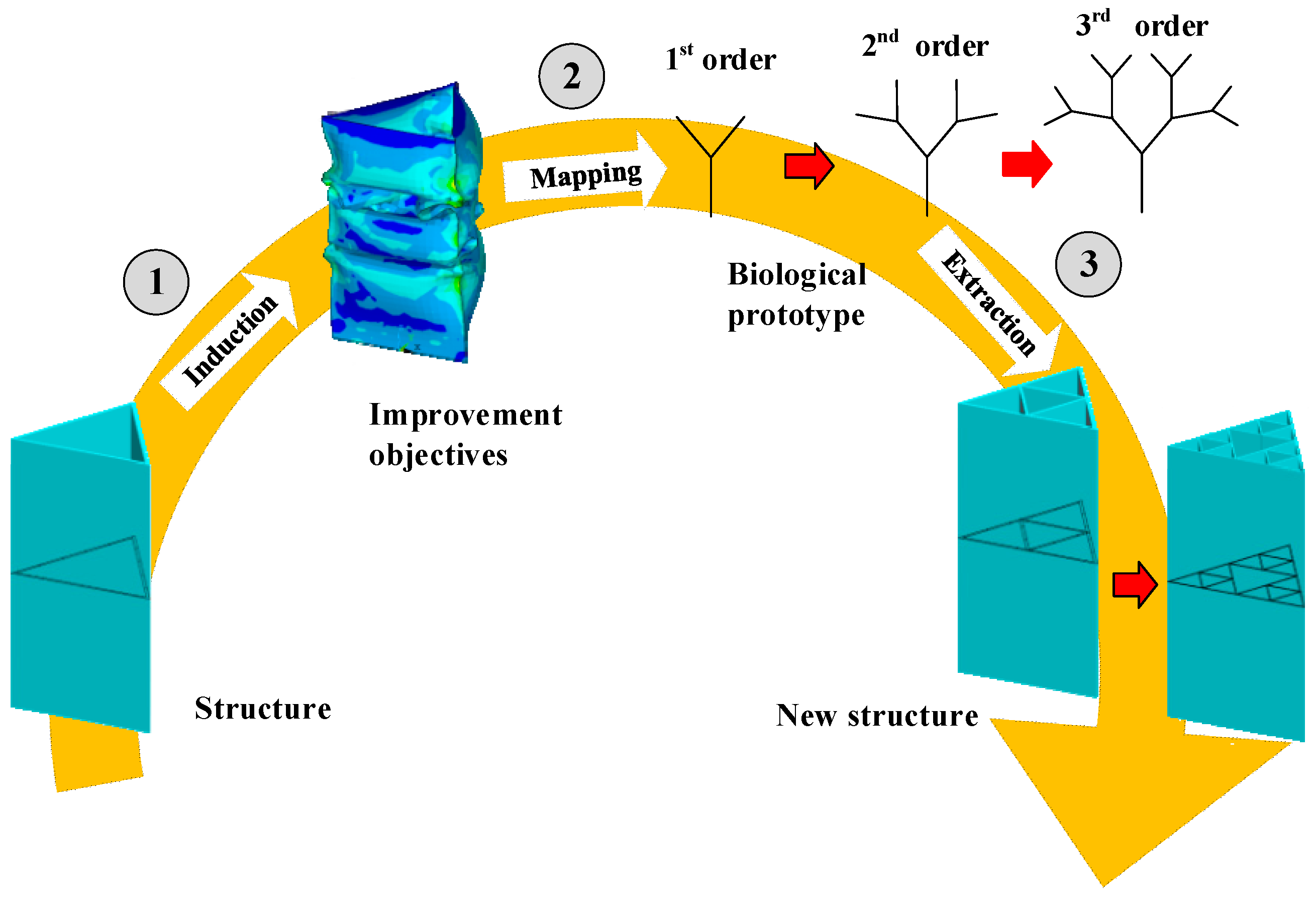



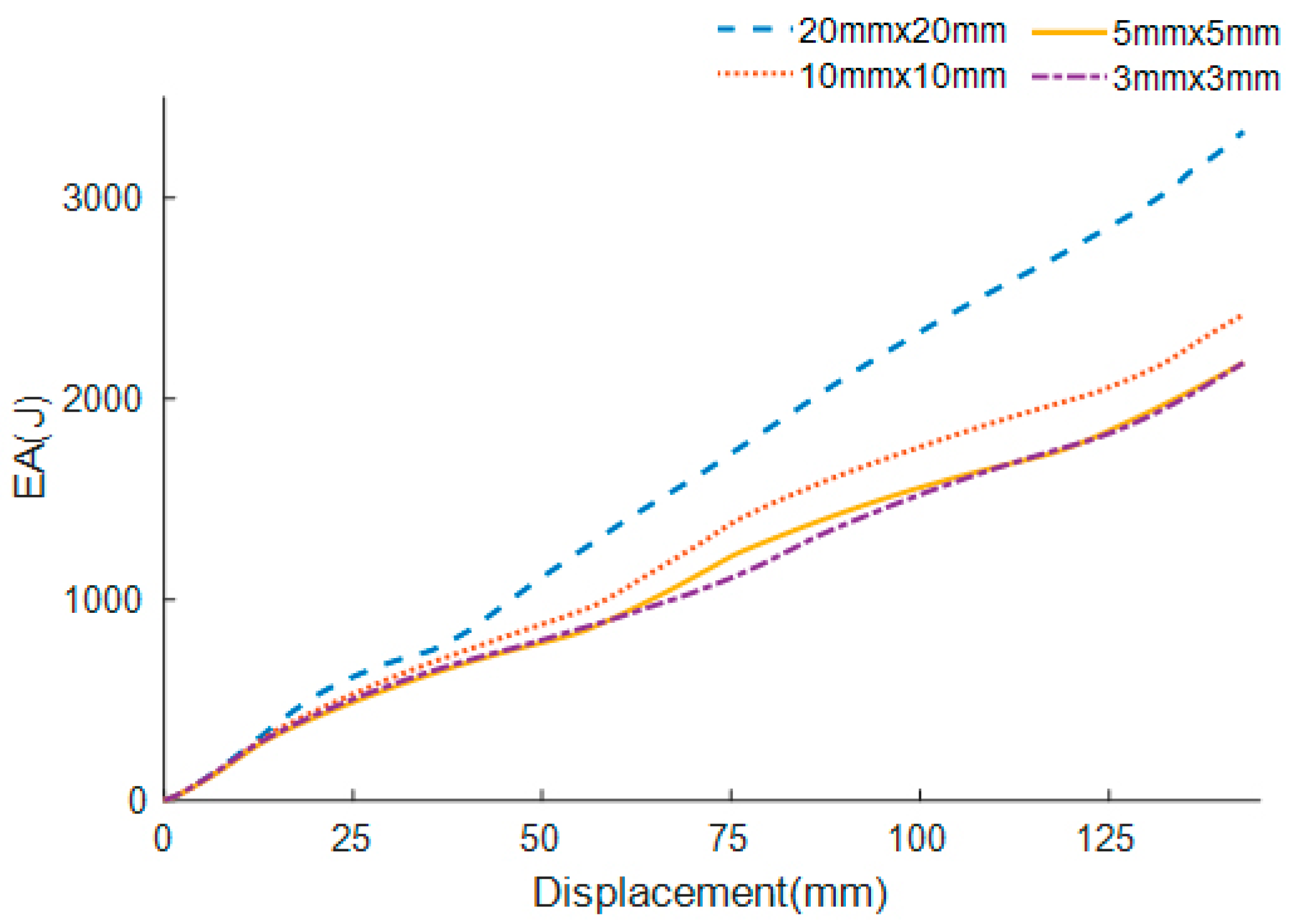

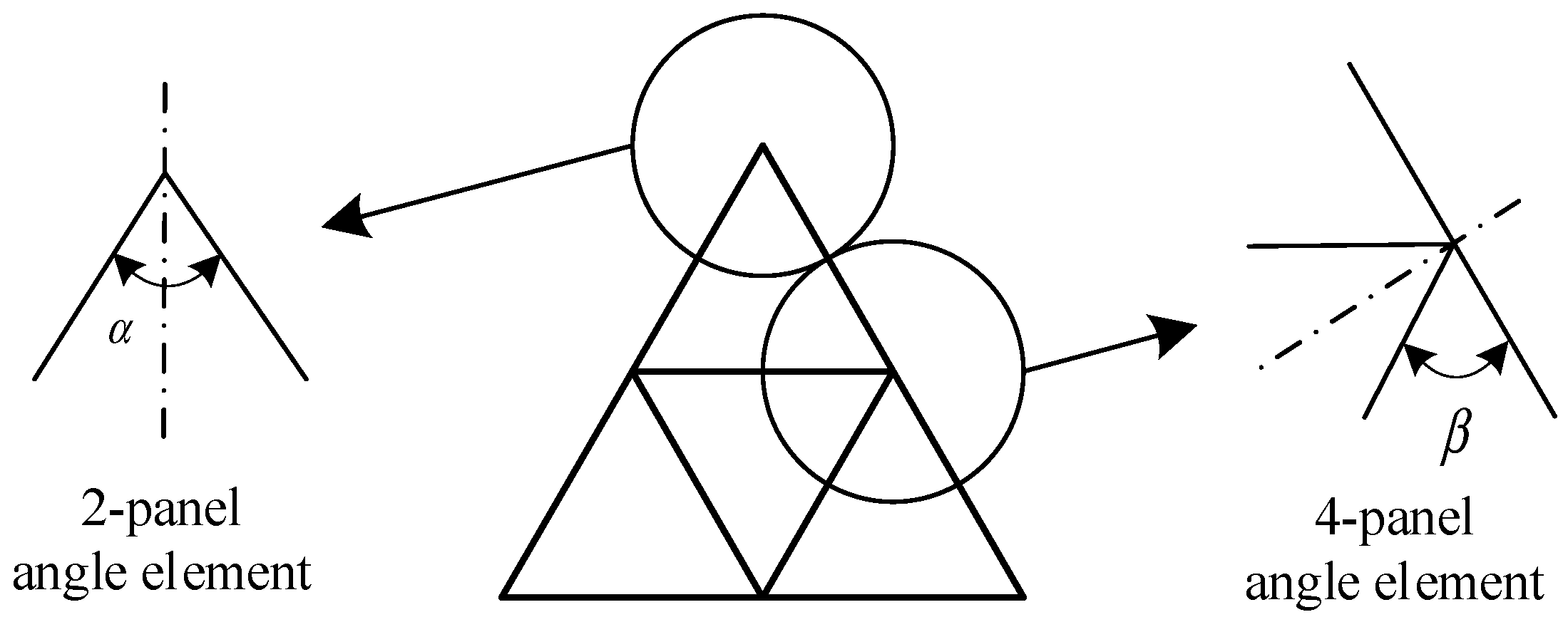

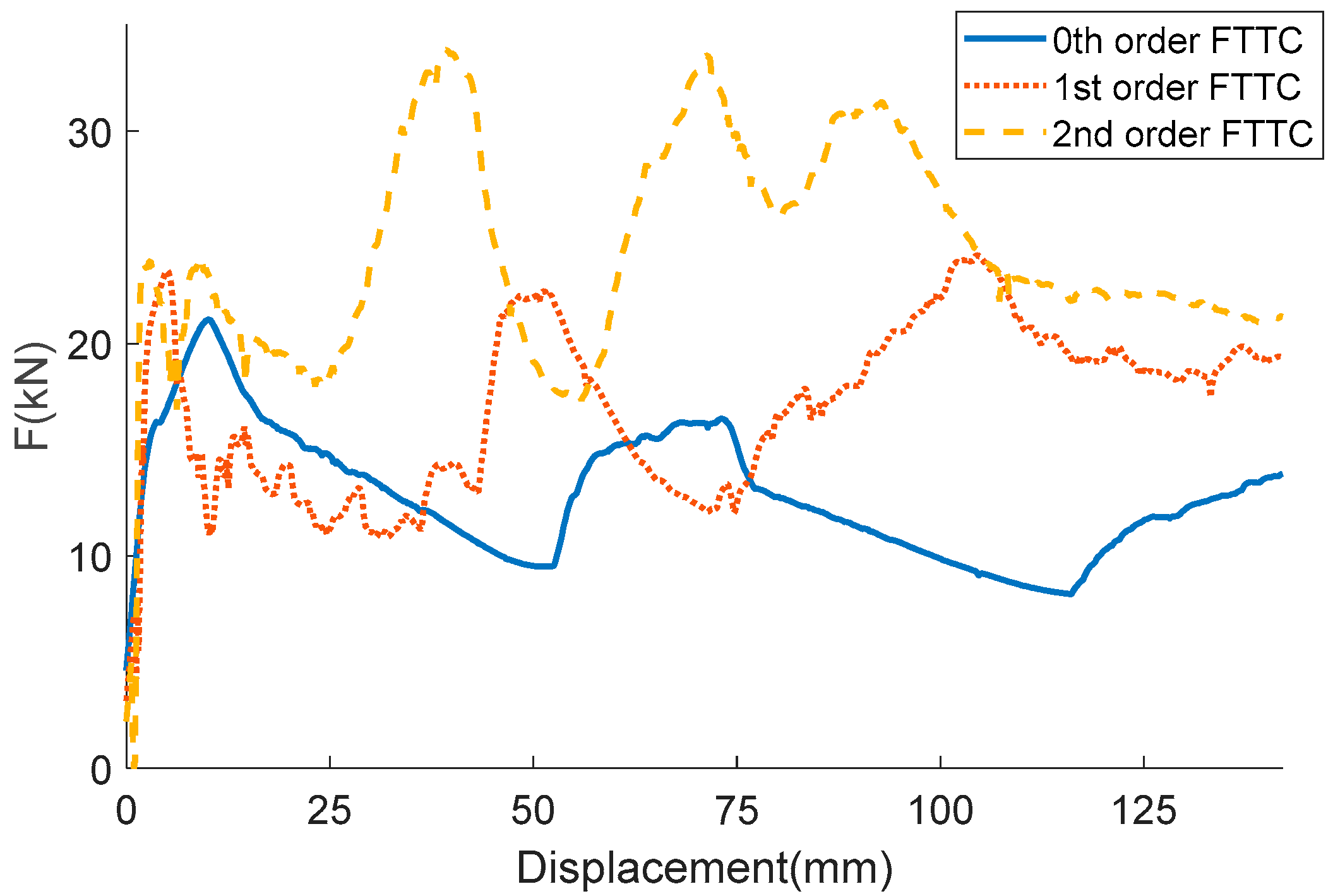
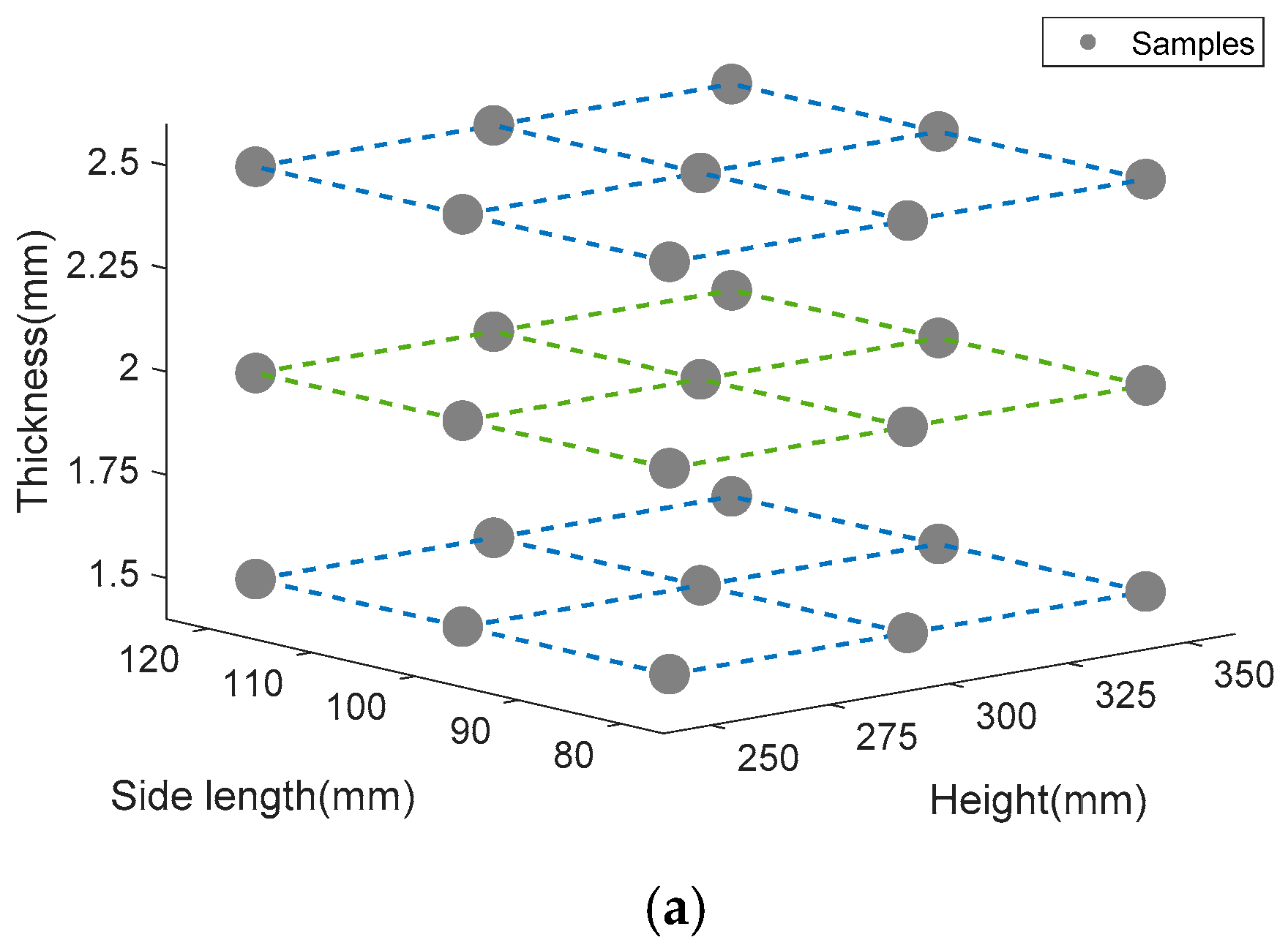
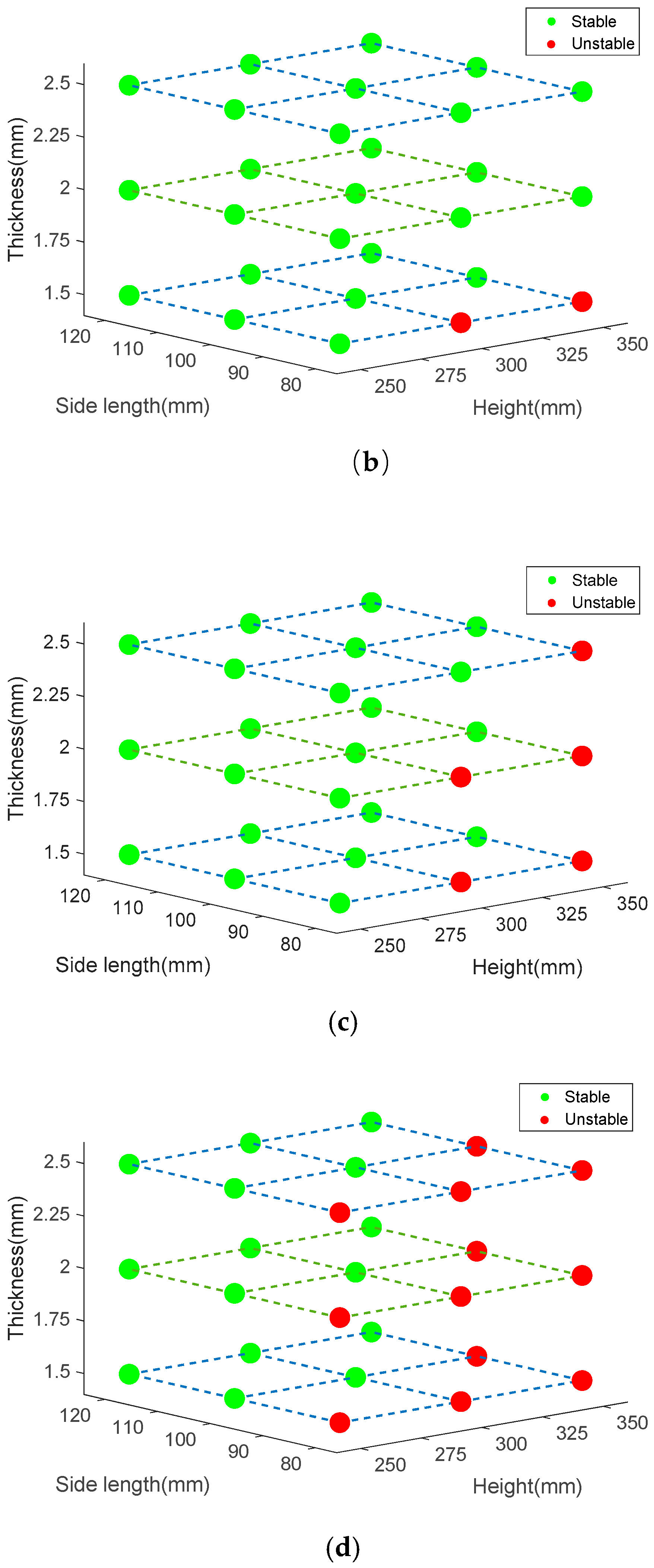


| Order n | Strategies | Section | Side Length | Side Number | Sides Length | Thickness |
|---|---|---|---|---|---|---|
| D | Q | L | t | |||
| 0th |  |  | D0 | 3 | 3D0 | t0 |
| 1st |  |  | D0/2 | 32 | 32D0/2 | 2t0/3 |
| 2nd |  |  | D0/4 | 33 | 33D0/4 | 4t0/9 |
| Properties | Value |
|---|---|
| Density (kg/m3) | 2700 |
| Young’s modulus (GPa) | 68.9 |
| Poisson’s ratio | 0.33 |
| Initial yield stress (MPa) | 68.8 |
| Ultimate stress (MPa) | 134.2 |
| Power law exponent | 0.18 |
| Rupture strain | 0.19 |
| Indicators | Experiment | FEA | Relative Error |
|---|---|---|---|
| EA (J) | 2053.9 | 1793.01 | 12.7% |
| SEA (J/kg) | 4226.2 | 3689.3 | 12.7% |
| MCF (kN) | 14.65 | 12.83 | 12.4% |
| Order n | Side Length (mm) | Height (mm) | Thickness (mm) |
|---|---|---|---|
| 0 | 100 | 300 | 2.000 |
| 1 | 50 | 300 | 1.333 |
| 2 | 25 | 300 | 0.889 |
| Order n | MCF (kN) | Theoretical (kN) | Relative Error (%) |
|---|---|---|---|
| 0th | 12.76 | 12.27 | 3.84 |
| 1st | 17.00 | 18.38 | 7.51 |
| 2nd | 24.21 | 27.73 | 14.54 |
| Indicators | 0th-Order FTTC | 1st-Order FTTC | 2nd-Order FTTC |
|---|---|---|---|
| SEA (kJ/kg) | 3.94 | 5.25 | 7.47 |
| MCF (kN) | 12.76 | 17.00 | 24.2 |
| CFE (%) | 60.42 | 70.36 | 71.56 |
| PCF (kN) | 21.12 | 24.16 | 33.83 |
© 2020 by the authors. Licensee MDPI, Basel, Switzerland. This article is an open access article distributed under the terms and conditions of the Creative Commons Attribution (CC BY) license (http://creativecommons.org/licenses/by/4.0/).
Share and Cite
Li, K.; Feng, Y.; Gao, Y.; Zheng, H.; Qiu, H. Crashworthiness Optimization Design of Aluminum Alloy Thin-Walled Triangle Column Based on Bioinspired Strategy. Materials 2020, 13, 666. https://doi.org/10.3390/ma13030666
Li K, Feng Y, Gao Y, Zheng H, Qiu H. Crashworthiness Optimization Design of Aluminum Alloy Thin-Walled Triangle Column Based on Bioinspired Strategy. Materials. 2020; 13(3):666. https://doi.org/10.3390/ma13030666
Chicago/Turabian StyleLi, Kangjie, Yixiong Feng, Yicong Gao, Hao Zheng, and Hao Qiu. 2020. "Crashworthiness Optimization Design of Aluminum Alloy Thin-Walled Triangle Column Based on Bioinspired Strategy" Materials 13, no. 3: 666. https://doi.org/10.3390/ma13030666
APA StyleLi, K., Feng, Y., Gao, Y., Zheng, H., & Qiu, H. (2020). Crashworthiness Optimization Design of Aluminum Alloy Thin-Walled Triangle Column Based on Bioinspired Strategy. Materials, 13(3), 666. https://doi.org/10.3390/ma13030666







